I have an end fed I bought when I first moved to Missouri just to get quickly get on the air but it just didn't do what I was hoping so I bought an 80-6 OCFD which works better. This fall when the leaves fall off the trees so I can see where to shoot the line, I'm going to put up a center fed doublet fed with home brew open wire feedline. I've always had excellent luck with those antennas. I will probably leave the OCFD up, at least for the time being as it works pretty well with the internal tuners in my radios. If I use the amp, I can tune anything with my AT2K tuner.I've never been a fan of end-fed antennas. I have never personally seen one that worked well on multiple bands. On the other hand, I have had great success with OCFD's. I suspect that a lot of people gravitate toward end fed antennas because of a desire to only have one high attachment point. In other words, simplicity. Unfortunately, simplicity frequently comes at a cost.
-
If you enjoy the forum please consider supporting it by signing up for a NES Membership The benefits pay for the membership many times over.
-
Be sure to enter the NES/MFS May Giveaway ***Canik METE SFX***
You are using an out of date browser. It may not display this or other websites correctly.
You should upgrade or use an alternative browser.
You should upgrade or use an alternative browser.
What did you do in the shack today?
- Thread starter CatSnoutSoup
- Start date
ToddDubya
NES Member
Yeah, the ease of setting up with only one end raised is why I like them. My other one is good on 40, 20, most of 15, and a good portion of 10. With good being below 2:1. With a tuner I'd have all four no problem. This one gets me 40 and 20 and I could have all four with a tuner. The windings were supposed to make it more efficient (less loss to heat) and I can't say it was with any scientific evidence, but anecdotally I got a lot of "Wow, that's a really strong signal" kinds of reports.I've never been a fan of end-fed antennas. I have never personally seen one that worked well on multiple bands. On the other hand, I have had great success with OCFD's. I suspect that a lot of people gravitate toward end fed antennas because of a desire to only have one high attachment point. In other words, simplicity. Unfortunately, simplicity frequently comes at a cost.
When I setup in a new place I put the analyzer on, see what the limits are and work with that. I'm often in a place where even one end is hard to do without having the wire snagged in 100 trees, so a dipole would be out of the question. Plus I can get by with 15' or less of coax.
After using a non-resonant antenna for a long time, I really like the simplicity of not using a tuner. Every antenna is a trade-off one way or another.
So the trade for portable is:
EFHW:
2 bands, with portions of 2 more
1 rope
short coax
easier setup in thick woods
no tuner
Dipole/OCFD:
More bands
2 ropes, maybe 3 (if heavy or for inverted vee)
longer coax
more difficult setup, if not impossible in thick woods
tuner required (OCFD)
I'm spoiled at home where I have 40/30/20/17/15/12/10 resonant on a DxCommander. I'll touch up 40 for the CW portion using my home rig's internal tuner. I love that antenna.
I looked up DxCommander, and there were a lot of things that make that description. Also, can you elaborate on your "fake" one? I am guessing this is a type of antenna, and you have plans for a certain one. Just wondering if that is correct, and if so, could you share your plans. Also, why you think this is the best route to take.thinking I should build a fake DxCommander
"O" Center Fed Dipoles?OCFD's
(If so, what is the "O"?)
There's that "O" again. Which did you buy, and why? Thanks.so I bought an 80-6 OCFD which works better
EFHW = End Fed Hard Ware?So the trade for portable is:
EFHW:
2 bands, with portions of 2 more
1 rope
short coax
easier setup in thick woods
no tuner
Dipole/OCFD:
More bands
2 ropes, maybe 3 (if heavy or for inverted vee)
longer coax
more difficult setup, if not impossible in thick woods
tuner required (OCFD)
I'm spoiled at home where I have 40/30/20/17/15/12/10 resonant on a DxCommander. I'll touch up 40 for the CW portion using my home rig's internal tuner. I love that antenna.
Have any pictures or diagrams of these 2? Good descriptions, but a photo would be helpful. Thanks again.
The "O" in OCFD stands for "Off" ...Off Center Fed Dipole (Ham Radio Site - <What's Wrong: OCFD>). Still a compromise antenna but it has compromises I can live with (for now).I looked up DxCommander, and there were a lot of things that make that description. Also, can you elaborate on your "fake" one? I am guessing this is a type of antenna, and you have plans for a certain one. Just wondering if that is correct, and if so, could you share your plans. Also, why you think this is the best route to take.
"O" Center Fed Dipoles?
(If so, what is the "O"?)
There's that "O" again. Which did you buy, and why? Thanks.
EFHW = End Fed Hard Ware?
Have any pictures or diagrams of these 2? Good descriptions, but a photo would be helpful. Thanks again.
The one I bought was the Palomar Engineers 1.5 KW balun and saved about $50 and used wire and insulators I already had to build the actual antenna:

Off Center Fed (OCF) 4:1 Balun and Choke Combo, 1.8-61 MHz, 1.5/3/5KW PEP - Off Center Fed (OCF) Antennas - Palomar Engineers®
5KW PEP rated 4:1 Current Balun + internal 1:1 Current Balun for OCF and loop (Skyloop or Delta loop) antennas - best combo balun with higher power, superior bandwidth to balun designs, dx engineering, array solutions, bytemark, comtek
 palomar-engineers.com
palomar-engineers.com
Last edited:
ChevyGuy91
NES Member
- Joined
- Mar 25, 2008
- Messages
- 22,955
- Likes
- 23,611
I have one of these on my desk, good unit and at $170, great buy.These are on sale right now. 80w of 2m FM glory for $170.

YAESU FT-2980R
144 MHz 80 Watt FM Mobile Transceiver - 3 Watts of RX Audio - With MH-48A6JA DTMF Microphonewww.hamradio.com
ToddDubya
NES Member
End Fed Half WaveI looked up DxCommander, and there were a lot of things that make that description. Also, can you elaborate on your "fake" one? I am guessing this is a type of antenna, and you have plans for a certain one. Just wondering if that is correct, and if so, could you share your plans. Also, why you think this is the best route to take.
"O" Center Fed Dipoles?
(If so, what is the "O"?)
There's that "O" again. Which did you buy, and why? Thanks.
EFHW = End Fed Hard Ware?
Have any pictures or diagrams of these 2? Good descriptions, but a photo would be helpful. Thanks again.
Basically you have a dipole, which is fed at the center of a half wavelength (each leg is 1/2 of a 1/2 wavelength, or 1/4 wavelength). Then an Off Center Fed Dipole, which is fed around 1/3 of a half wavelength (one leg 1/3, the other 2/3). At the extreme is an EFHW, which as the name implies is fed at one end.
A basic dipole has an impedance about 72 ohms at the feed point, which is a decent match for a 50 ohm system. These are resonant at the designed frequency and can be good at odd harmonics. So a 40m (7 MHz) dipole will also be "good" on 15m (7 MHz x 3).
An OCFD has an impedance of about 200 ohms at the feed point, and use a 4:1 balun/unun to provide a good match for a 50 ohm system. These are not resonant at any frequency, but are close enough for a tuner to get a good match. They have the benefit of being "good" on even and odd harmonics
. An OCFD designed for 40m (7 MHz) will also be "good" on 20m (7 MHz x 2), 15m (7 MHz x 3), and 10m (7 MHz x 4).
An EFHW has an impedance of about 2500 ohms at the feed point, and uses a 49:1 balun/unun to provide a good match for a 50 ohm system. These can be resonant on a few bands. Like the OCFD, an EFHW antenna designed for 40m (7 MHz) will also be "good" on 20m (7 MHz x 2), 15m (7 MHz x 3), and 10m (7 MHz x 4).
There are a number of things that go into the definition of "good". But above are the basics of it.
Dipole:
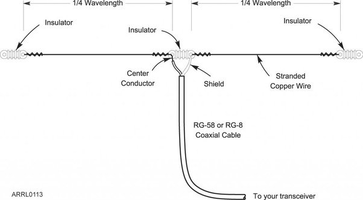
OCFD:
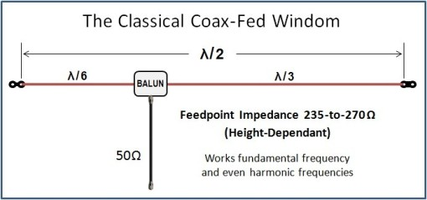
EFHW:
For some reason I can't find a simple picture of one. But I set mine up as high at one end as I can get it, usually aiming for 45 degree angle. The other end is the 49:1 transformer (unun) near the ground, which connects to the radio via coax. So a 40m EFHW is about 67' of wire up into a tree about 45' high and the bottom is the transformer. That's about the most basic setup.
ToddDubya
NES Member
You have voice privileges on 10m and 6m. Enough to get your feet wet on HF anyway.Thank you. That reply was above and beyond. One of these days, I'll get a radio for those frequencies, and build one of these.
ToddDubya
NES Member
Well, I haven't done anything yet but I scored an old aluminum folding chair in the trash that I want to fashion into a 6m (or 2m) squalo.
There's this version:
View: https://www.youtube.com/watch?v=U3ZGJWuzgRs
Article here: Squalo antenna for 6m – Ernest Neijenhuis PA3HCM Homepage
Or this one:

 outbackofbeyond.wordpress.com
outbackofbeyond.wordpress.com
I'll have to dismantle the chair and see what I have for parts.
There's this version:
View: https://www.youtube.com/watch?v=U3ZGJWuzgRs
Article here: Squalo antenna for 6m – Ernest Neijenhuis PA3HCM Homepage
Or this one:

6m Squalo from a lawn chair
What does an old lawn chair have to do with Amateur Radio? Now that I have a 6m rig I need to build an antenna to operate on this band. I was wavering between a Moxon and a Squalo and after a disc…
I'll have to dismantle the chair and see what I have for parts.
Well, I haven't done anything yet but I scored an old aluminum folding chair in the trash that I want to fashion into a 6m (or 2m) squalo.
There's this version:
View: https://www.youtube.com/watch?v=U3ZGJWuzgRs
Article here: Squalo antenna for 6m – Ernest Neijenhuis PA3HCM Homepage
Or this one:

6m Squalo from a lawn chair
What does an old lawn chair have to do with Amateur Radio? Now that I have a 6m rig I need to build an antenna to operate on this band. I was wavering between a Moxon and a Squalo and after a disc…outbackofbeyond.wordpress.com
I'll have to dismantle the chair and see what I have for parts.
I watched his video...he did a great job. I built a simple 6 meter squalo many years ago out of heavy solid copper wire and it worked but couldn't stand the weight of the snow and it eventually pretzeled on me. After that, I built a 3 element 6 meter yagi and that lasted a lot longer. It actually worked quite well and I made many contacts with it over the years. I turned it first with the "armstrong" method (turning the mast by hand) but that got old fast so I bought a TV antenna rotator at Radio Shack and used that until I moved and packed it away. I think I gave the antenna to my brother who lives in Coos County...not sure if he ever installed it.
I now have a 5 element 6 meter beam (long boom) that is still in the box. I'm really hoping to get a 40-50 foot tower up in the next year or two and I'll put that on it as well as a small tribander HF yagi. I just bought a Diamond V-2000 triband vertical (6/2/440) a few weeks back at a hamfest I went to. I'm hoping to get that up this weekend on a 35' fiberglass mast where a Diamond X-500 dual band vertical lives right now. I'll remove the dual band vertical and replace it with the tribander. At least that will give me a resonant antenna on 6. I've been using my OCFD on 6 but it doesn't work as well as I think it should.
A note about the video...after he got the antenna in the air and checked VSWR, it looked like it was almost 1:1. Not sure why he ran the internal tuner to "tune" the antenna. It was already tuned. There's quite a bit of loss through many of those internal tuners. On VHF, you want to keep losses as low as possible. Putting a lossy tuner into the mix would be counter productive, I would think.
Anyway, have fun building the squalo. They actually work quite well.
Last edited:
RubiconLJ
NES Member
Spent some time on the Karma'd Alinco DJ-500T Gen 1.
New battery installed.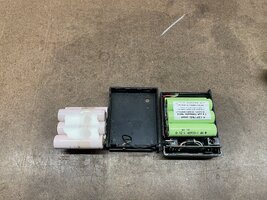
Looks like it taking a charge.
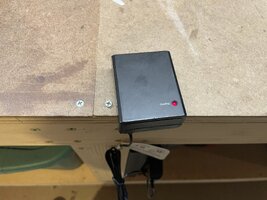
Was able to get a successful transmit on Simplex to one of my HTs. Can hear the local repeater at 146.850, need to figure out the tone settings still.
If anyone has any experience with programming the tones on one of these, please let me know. The online manual was less than helpful and it doesn't seem that the programming of a memory channel saves the tone for that channel.
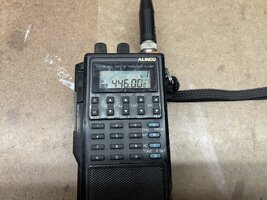
Thanks to Horizontal Hunter for the Karma.
New battery installed.

Looks like it taking a charge.

Was able to get a successful transmit on Simplex to one of my HTs. Can hear the local repeater at 146.850, need to figure out the tone settings still.
If anyone has any experience with programming the tones on one of these, please let me know. The online manual was less than helpful and it doesn't seem that the programming of a memory channel saves the tone for that channel.

Thanks to Horizontal Hunter for the Karma.
ToddDubya
NES Member
I finally spent the ten minutes it would take to put a real speaker on my FTDX10. I kept telling myself I should buy the one from Yaesu but A) that thing is $170, B) from what I can tell it's just a speaker (no special filtering or anything), and C) I have speakers a-go-go all around the house that are just collecting dust.
I would have liked if the speaker was a little smaller; it's your standard run of the mill bookshelf speaker from Polk Audio. I have it on it's side, the radio sits on top, and the laptop is on top of the radio. Man oh man does it sound better. What have I been doing to myself all this time?
I would have liked if the speaker was a little smaller; it's your standard run of the mill bookshelf speaker from Polk Audio. I have it on it's side, the radio sits on top, and the laptop is on top of the radio. Man oh man does it sound better. What have I been doing to myself all this time?
ToddDubya
NES Member
Not to drone on about this stupid speaker, but what an improvement. It's like a whole new radio. Not only does it magically clean up the audio (it's just a bookshelf speaker, no filtering that I know of), but I can also turn down/off the noise reduction in the radio too, which can also filter out weak signals when the bands are "closed". I worked a few stations last night on 15m after it had closed. They didn't even move the S-meter, yet I could hear them just fine. With noise reduction on the lowest setting, they were difficult to make out.
I checked out the QRZ page for one of the guys I worked late last night and he has an interesting vertical I might have to try. It's a 3/8"-24 antenna mount with a 1/2" pipe clamped over it for 15m. Looks simple as hell. My theory is to make one for 6m with a coupler on the top end, then have a few lengths of pipe to add on and get 10m, 12m, 15m, 17m. To change bands, just replace the top section. I don't know how good of a connection you get just sliding a length of pipe into a fitting, but it's worth a shot.
I've got a 5' piece of 1/2" pipe in the basement I think I'll shorten a hair for 6m and see how it does. Well, see how it tunes anyway. Performance on 6m can be tough to gauge without an opening. Edit: Balls, the pipe I have is only 4'2". I guess I'll have to run to the store tonight.
This guy (WB0RLJ) is an avid POTA activator, and his call sign sounds so nice on CW that I looked him up. Funny what that leads to.
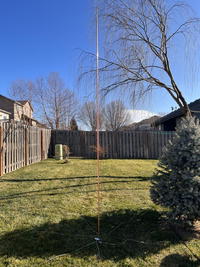

I checked out the QRZ page for one of the guys I worked late last night and he has an interesting vertical I might have to try. It's a 3/8"-24 antenna mount with a 1/2" pipe clamped over it for 15m. Looks simple as hell. My theory is to make one for 6m with a coupler on the top end, then have a few lengths of pipe to add on and get 10m, 12m, 15m, 17m. To change bands, just replace the top section. I don't know how good of a connection you get just sliding a length of pipe into a fitting, but it's worth a shot.
I've got a 5' piece of 1/2" pipe in the basement I think I'll shorten a hair for 6m and see how it does. Well, see how it tunes anyway. Performance on 6m can be tough to gauge without an opening. Edit: Balls, the pipe I have is only 4'2". I guess I'll have to run to the store tonight.
This guy (WB0RLJ) is an avid POTA activator, and his call sign sounds so nice on CW that I looked him up. Funny what that leads to.


Last edited:
ChevyGuy91
NES Member
- Joined
- Mar 25, 2008
- Messages
- 22,955
- Likes
- 23,611
I finally moved my wife's crap out of my office and into hers and took over the whole desk for myself. While I am trying to scrape the money together to catch HRO's deal on the IC-7300 and waiting for the FCC to approve my vanity call sign, I started finally playing with the RTLSDR I bought like 3 years ago. I am currently using the little dipole it came with, anyone have a suggestion for a better antenna setup for it? With my new found desk space, I plan to mount a 30" ultra wide monitor to watch the matrix over my radios.
ToddDubya
NES Member
I could be wrong, but can't you just use a long ass wire for a receive antenna?
What sale are you waiting on? They are on sale for $1k (after rebate). Or are you waiting on cash to take advantage of the sale. In my professional opinion, it would be irresponsible to not buy it immediately while it's on sale.
What sale are you waiting on? They are on sale for $1k (after rebate). Or are you waiting on cash to take advantage of the sale. In my professional opinion, it would be irresponsible to not buy it immediately while it's on sale.
ChevyGuy91
NES Member
- Joined
- Mar 25, 2008
- Messages
- 22,955
- Likes
- 23,611
Well I just spent all the fun money I had stashed away on roofing material, so I am trying to scratch the money back together to buy it.I could be wrong, but can't you just use a long ass wire for a receive antenna?
What sale are you waiting on? They are on sale for $1k (after rebate). Or are you waiting on cash to take advantage of the sale. In my professional opinion, it would be irresponsible to not buy it immediately while it's on sale.
I was reading about discone antennas for the SDR but wasn't sure it was worth the $160 they cost.
ToddDubya
NES Member
Well that was a fail. I got it assembled for 6m (50.125 MHz), which is a 4'8" quarter wave. Mounted it to a mirror mount bolted to rebar jammed in the ground (same setup as I use for ham sticks) and the SWR dip is at 35MHz. Not even close. That equates to a 1/4 wave of 6'8". How the hell can it be so far off?
To assemble I slit the end of the pipe so it would slide over the nut on top of the mirror mount (see example below). It still took some convincing, so it's definitely making contact at least on the points of the nut.
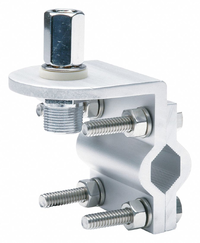
SWR plot. I tried it with and without radials and it adjusted the SWR down a hair with radials, but not significantly.
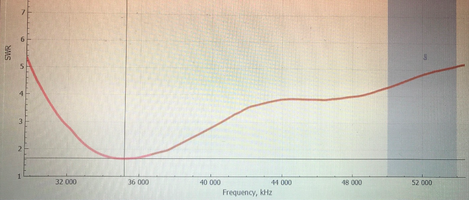
To assemble I slit the end of the pipe so it would slide over the nut on top of the mirror mount (see example below). It still took some convincing, so it's definitely making contact at least on the points of the nut.

SWR plot. I tried it with and without radials and it adjusted the SWR down a hair with radials, but not significantly.

Every time Radio shack put their minimus or optimus series speakers on sale, I'd buy a pair....I think I have 6 or 8 pairs now and they make great HF radio speakers...if there's too much low end in them for you, it's easy to install a passive low cut network in them but I use them as is. They are available for pretty short money on ebay...I finally spent the ten minutes it would take to put a real speaker on my FTDX10. I kept telling myself I should buy the one from Yaesu but A) that thing is $170, B) from what I can tell it's just a speaker (no special filtering or anything), and C) I have speakers a-go-go all around the house that are just collecting dust.
I would have liked if the speaker was a little smaller; it's your standard run of the mill bookshelf speaker from Polk Audio. I have it on it's side, the radio sits on top, and the laptop is on top of the radio. Man oh man does it sound better. What have I been doing to myself all this time?

Realistic Minimus 77 Speaker Excellent! 5 Day Auction | eBay
Find many great new & used options and get the best deals for Realistic Minimus 77 Speaker Excellent! 5 Day Auction at the best online prices at eBay! Free shipping for many products!
www.ebay.com
Good to know as I have a pair of them in my storage unit. So if I ever get HF setup, I'll use the Minimus speaker with it.Every time Radio shack put their minimus or optimus series speakers on sale, I'd buy a pair....I think I have 6 or 8 pairs now and they make great HF radio speakers...if there's too much low end in them for you, it's easy to install a passive low cut network in them but I use them as is. They are available for pretty short money on ebay...

Realistic Minimus 77 Speaker Excellent! 5 Day Auction | eBay
Find many great new & used options and get the best deals for Realistic Minimus 77 Speaker Excellent! 5 Day Auction at the best online prices at eBay! Free shipping for many products!www.ebay.com
I think I have three pairs being used for music. They actually don't sound too bad when used as "Near Field" monitors.I'm down to my last 7 spare bookshelf speakers and one center channel speaker. Technically two are somewhat in service for music.
Last edited:
The previous homeowner also left me 2 Bose speakers that are the same size as the Minimus 77.
ToddDubya
NES Member
I got a little inspired to run some more tests with the free MFJ 9:1 unun I got when I bought something one time. I cut a perfectly random 35.5000000' length of wire and ran some tests with counterpoises, no counterpoises, different lengths of coax. My best combination is the 30' coax with a choke at the radio end, or the same setup with the 12' coax. Counterpoises made the SWR significantly worse. I'll have to get some shots of the SWR traces, but 40-6m is pretty tunable. I think 17 and 15 could be used without a tuner.
I'm sure if I had moved the choke to the 9:1 unun end the counterpoises would have helped. But this random wire setup isn't for home use, so there's less concern about "RF in the shack". Having the bulky choke on a table instead of wherever the unun ends up seems like the most convenient setup.
* Those were the two lengths of coax I had handy and would likely bring with me in the field.
Yeah, it's a compromise but for field use a 35' wire seems much handier than the 67' wire I use on my EFHW, and I get more bands (with a tuner). And something else to play with. If it works out I might pick up the MFJ 1:1 inline choke to save on the bulkiness of the setup.
Update:
Here's a comparison of the 12ft and 30ft coax setups. 30ft is better pretty much in every band, but 12ft picks up 60m if I ever wanted to use that.
Update again: 30' is purple trace, 12' is the orange trace.
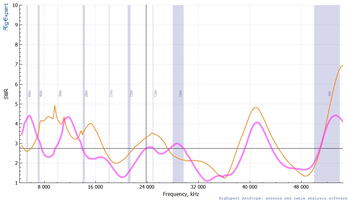
I'm sure if I had moved the choke to the 9:1 unun end the counterpoises would have helped. But this random wire setup isn't for home use, so there's less concern about "RF in the shack". Having the bulky choke on a table instead of wherever the unun ends up seems like the most convenient setup.
* Those were the two lengths of coax I had handy and would likely bring with me in the field.
Yeah, it's a compromise but for field use a 35' wire seems much handier than the 67' wire I use on my EFHW, and I get more bands (with a tuner). And something else to play with. If it works out I might pick up the MFJ 1:1 inline choke to save on the bulkiness of the setup.
Update:
Here's a comparison of the 12ft and 30ft coax setups. 30ft is better pretty much in every band, but 12ft picks up 60m if I ever wanted to use that.
Update again: 30' is purple trace, 12' is the orange trace.

Last edited:
n1oty
NES Member
I got a little inspired to run some more tests with the free MFJ 9:1 unun I got when I bought something one time. I cut a perfectly random 35.5000000' length of wire and ran some tests with counterpoises, no counterpoises, different lengths of coax. My best combination is the 30' coax with a choke at the radio end, or the same setup with the 12' coax. Counterpoises made the SWR significantly worse. I'll have to get some shots of the SWR traces, but 40-6m is pretty tunable. I think 17 and 15 could be used without a tuner.
I'm sure if I had moved the choke to the 9:1 unun end the counterpoises would have helped. But this random wire setup isn't for home use, so there's less concern about "RF in the shack". Having the bulky choke on a table instead of wherever the unun ends up seems like the most convenient setup.
* Those were the two lengths of coax I had handy and would likely bring with me in the field.
Yeah, it's a compromise but for field use a 35' wire seems much handier than the 67' wire I use on my EFHW, and I get more bands (with a tuner). And something else to play with. If it works out I might pick up the MFJ 1:1 inline choke to save on the bulkiness of the setup.
Update:
Here's a comparison of the 12ft and 30ft coax setups. 30ft is better pretty much in every band, but 12ft picks up 60m if I ever wanted to use that.
Update again: 30' is purple trace, 12' is the orange trace.
View attachment 796188
SWR calculations are great, but what is the radiation resistance of the antenna? A Smith Chart calculation would tell you more about actual potential performance. Don't forget, even a dummy load has a nearly perfect SWR.
ToddDubya
NES Member
Enjoy 
I understand the basics of the Smith chart, but it's not the easiest thing for me to use. I'd love to learn so if you have any references beyond "This is what a Smith Chart is", send 'em my way.
My analyzer will give the R+jZ (if on the laptop, as I mouse over) so I use that as I move across the SWR chart to see if I'm being misled. Ultimately the proof is in the pudding. I'm hoping to get this out this weekend and see how it does. Obviously it's compromised, but after working Europe on a ham stick mounted to a length of rebar jammed in the yard next to the house under the power lines with no radials I have adopted a "let's just see how it does" approach.
Fun story, last night after 15m was closed I worked two stations SSB in Japan. QRZ tells me they were 6,666 miles away. 1/4 wave vertical for 40m on the third harmonic with "too-short" radials when the band was completely quiet. No way it should have worked, but I could hear one clearly, and had a downright proper QSO with him. The other, a YL with a soft voice, less so. She sounded hot, though.
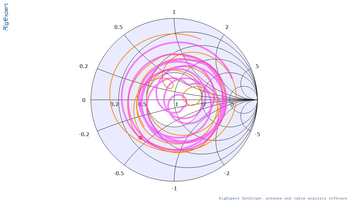
I understand the basics of the Smith chart, but it's not the easiest thing for me to use. I'd love to learn so if you have any references beyond "This is what a Smith Chart is", send 'em my way.
My analyzer will give the R+jZ (if on the laptop, as I mouse over) so I use that as I move across the SWR chart to see if I'm being misled. Ultimately the proof is in the pudding. I'm hoping to get this out this weekend and see how it does. Obviously it's compromised, but after working Europe on a ham stick mounted to a length of rebar jammed in the yard next to the house under the power lines with no radials I have adopted a "let's just see how it does" approach.
Fun story, last night after 15m was closed I worked two stations SSB in Japan. QRZ tells me they were 6,666 miles away. 1/4 wave vertical for 40m on the third harmonic with "too-short" radials when the band was completely quiet. No way it should have worked, but I could hear one clearly, and had a downright proper QSO with him. The other, a YL with a soft voice, less so. She sounded hot, though.

ToddDubya
NES Member
Sometimes a little hotness gives you the last few dB you need to get through.LOL...How many of us look up the other op on QRZ hoping to see a picture when it is a YL just to see if she is hot (or not)?
indeed!Sometimes a little hotness gives you the last few dB you need to get through.
Share:


